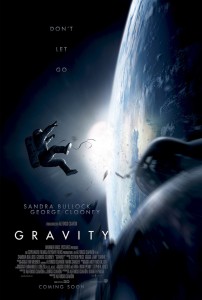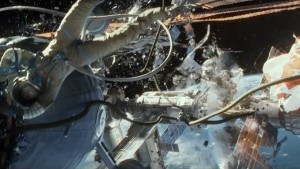 And the award for Best Visual Effects goes to….
And the award for Best Visual Effects goes to….
Since I started this blog back in January of 2012, I have never done a review of a film quite like “Gravity.” It would be hard to place it into any one recognized film genre. This is a story of survival that may be similar to those you have heard of, such as Aron Ralston’s story in the film “127 Hours.” But this is placed way above our own familiar environment, in a setting usually reserved for aliens and futuristic galaxy travel: the vast emptiness of space. Words cannot fully justify the extent of this experience, though I will try my best. But this is really something you have to see for yourself.
Dr. Ryan Stone (Sandra Bullock) is a medical engineer, currently on her first mission in space aboard the space shuttle Explorer. Matt Kowalski (George Clooney), a longtime astronaut, is her commander. While attempting to fix a telescope, they are suddenly warned by Houston of an impending crisis: a Russian satellite was blown up, and its debris has spread into other surrounding satellites, all of which is now heading in their direction. No sooner do we hear their warning when, like a speeding bullet, the crew and ship is suddenly torn into by an intense hurricane of smashing satellite-parts, from which only Stone and Kowalski emerge unscathed. And, to make matters worse, the satellite connecting the astronauts to Earth has also been destroyed, leaving them alone in the dark. Think of “Apollo 13,” but with no Houston to guide them home.
As the film’s opening lines state: in space, there is no sound, no light, and no gravity. If separated from your spacecraft, as Stone soon is, you will continue to drift endlessly, unless something manages to stop you. So, after being knocked out of reach from the ship, Stone continues to spin out of control. And director Alfonso Cuarón, with no regard for nausea-induced audience members, takes us right along with her. On one side, we see nothing but desperately empty blackness; on the other, an illumination of the bright orb of our own blue planet, which is now drifting farther and farther away.
Throughout the length of “Gravity,” there is really no single moment (maybe one) that the camera remains stationary. We either drift along with our two principle cast members, see POV shots through their space helmets, or travel in circling arcs, perceiving them as tiny dots in the distance. In Cuarón’s last project “Children of Men,” there is a long tracking shot towards the end of the film, in which we see the characters wander through a hectic war-zone. In “Gravity,” the extended camera shots are used to similar effect, though, as mentioned, the atmosphere is soundless here. So, as the giant arm of a satellite swings around and smashes into the side of a space shuttle, there are no explosive bangs or crashes. The intensity of these moments comes only through the reactions from Kowalski or Stone: heavy breathing, upset voices, or the labored screams of a person desperately fighting for their life. And, at all times, it is intensified by the electronic spirals of Steven Price’s form-fitting musical score.
Not since “Life of Pi” or “Avatar” has digital technology so seamlessly fit a movie. Yet unlike these two previous films, the CGI in “Gravity” is not meant to create an alien or dream-like effect. Instead, it serves to create as realistic a world as possible. A tiny droplet of water seeps from Stone’s eye, and sails gently out in front of her. A pen floats gracefully around her head, as pieces of satellites soar through the air outside the space module, reflecting on the glinting sun, which has just started to peak its face from around the corner. As harrowing as much of this movie is, this is also, at times, a poetic experience.
“Gravity” is, essentially, an allegory of the many cycles of human life. There is birth, struggle, companionship, loss, and, through it all, the will to survive. At one moment, Stone is shown floating in a fetal position when first coming inside a space module, her arms wrapped around her legs, as if still inside the mother’s womb. This one shot shows Stone’s renewed strength of survival after the start of her ordeal. She will soon emerge from this experience, reborn and ready to fight for her life rather than lay down and accept this as the end. It is the influence of Kowalski’s calm confidence at the start that finally convinces Stone that she must survive, and that she must take control, despite her losses in her life back on Earth. With the exception of the first twenty minutes with Clooney, this really is a one-man (woman) show, and Bullock manages to carry the full weight of “Gravity.” This is the type of performance that deserves Academy recognition, which would make it the second nomination for Bullock in only the last couple of years.
At once a virtual roller-coaster simulator ride, “Gravity” is also the most visually splendid film of 2013, at least thus far. And it’s unlikely that another film will come close. A dizzying, entertaining, terrifying adventure; this must be seen in 3D, and on an IMAX screen, if possible. That’s how I intend to see it for my second viewing.

1:05 pm on January 30th, 2014 1
[…] of which had superheroes of some sort, nothing could come quite close to the exhilarating “Gravity.” This is one of the most impressively realistic space films I have ever seen. And yet, it is […]